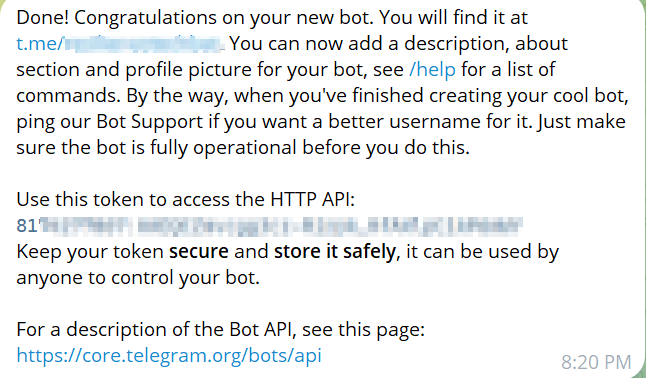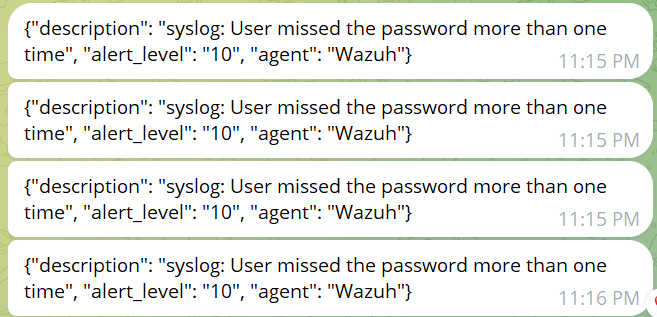How to Integrate Wazuh and Telegram to Receive Alerts
 Bisola Adediji
Bisola Adediji
Integrating Wazuh with Telegram allows you to receive real-time security alerts via Telegram messages. This integration involves using Wazuh's API to send alerts to a Telegram bot. The bot can then forward these messages to your Telegram chat or group.
Here's a step-by-step guide to integrating Wazuh and Telegram for real-time alerts:
Create a Telegram Bot
First, you need to create a Telegram bot that will send the alerts to your chat or group.
Open Telegram and search for the user
@BotFather. This is the official bot that helps you create new bots on Telegram.Start a conversation with
@BotFatherby sending the/startcommand.Create a new bot by sending
/newbotand following the instructions. You will be asked to provide:A name for your bot.
A unique username that ends with
bot(e.g.,WazuhAlertBot).
After successfully creating the bot, you will receive a bot token. This token will be used to authenticate requests and send messages via the Telegram API.
Copy the token provided by
@BotFather. You will use this token later.

Get Your Chat ID or Group ID
Next, you need to identify the chat ID or group ID where the alerts will be sent.
Find your Chat ID:
If you want to receive alerts in a private chat with your bot, send any message to the bot.
Use this URL (in a browser) to get your chat ID:
https://api.telegram.org/bot<YourBotToken>/getUpdates
Replace <YourBotToken> with the actual token you got from @BotFather.
This will show you the chat information in JSON format. Look for the chat object, and find the id field, which is your chat ID.

Find your Group ID:
If you want to send alerts to a group, first add the bot to the desired group.
Send a message in the group.
Then, use the same URL as above to retrieve the
group_id.
Create Python Wrapper
To create the wrapper, run
nano /var/ossec/integrations/custom-telegramas root.Copy and paste this code into the wrapper
```plaintext #!/bin/sh
WPYTHON_BIN="framework/python/bin/python3"
SCRIPT_PATH_NAME="$0"
DIR_NAME="$(cd $(dirname ${SCRIPT_PATH_NAME}); pwd -P)" SCRIPT_NAME="$(basename ${SCRIPT_PATH_NAME})"
case ${DIR_NAME} in /active-response/bin | /wodles*) if [ -z "${WAZUH_PATH}" ]; then WAZUH_PATH="$(cd ${DIR_NAME}/../..; pwd)" fi
PYTHON_SCRIPT="${DIR_NAME}/${SCRIPT_NAME}.py" ;; */bin) if [ -z "${WAZUH_PATH}" ]; then WAZUH_PATH="$(cd ${DIR_NAME}/..; pwd)" fi
PYTHON_SCRIPT="${WAZUH_PATH}/framework/scripts/${SCRIPT_NAME}.py" ;; */integrations) if [ -z "${WAZUH_PATH}" ]; then WAZUH_PATH="$(cd ${DIR_NAME}/..; pwd)" fi
PYTHON_SCRIPT="${DIR_NAME}/${SCRIPT_NAME}.py" ;; esac
${WAZUH_PATH}/${WPYTHON_BIN} ${PYTHON_SCRIPT} "$@"
### Create the Python Script
* Create a .py file by running `nano /var/ossec/integrations/custom-telegram.py`
* Copy and paste the code below into the wrapper and replace the **CHAT\_ID** variable with your chat ID.
```plaintext
#!/usr/bin/env python
import sys
import json
import requests
from requests.auth import HTTPBasicAuth
#CHAT_ID="xxxx"
CHAT_ID=""
# Read configuration parameters
alert_file = open(sys.argv[1])
hook_url = sys.argv[3]
# Read the alert file
alert_json = json.loads(alert_file.read())
alert_file.close()
# Extract data fields
alert_level = alert_json['rule']['level'] if 'level' in alert_json['rule'] else "N/A"
description = alert_json['rule']['description'] if 'description' in alert_json['rule'] else "N/A"
agent = alert_json['agent']['name'] if 'name' in alert_json['agent'] else "N/A"
# Generate request
msg_data = {}
msg_data['chat_id'] = CHAT_ID
msg_data['text'] = {}
msg_data['text']['description'] = description
msg_data['text']['alert_level'] = str(alert_level)
msg_data['text']['agent'] = agent
headers = {'content-type': 'application/json', 'Accept-Charset': 'UTF-8'}
# Send the request
requests.post(hook_url, headers=headers, data=json.dumps(msg_data))
sys.exit(0)
Update permissions
chown root:ossec /var/ossec/integrations/custom-telegram* chmod 750 /var/ossec/integrations/custom-telegram*
Integration with Wazuh
On your Wazuh manager, open the ossec.conf file-
nano /var/ossec/etc/ossec.confScroll to integrations and add your telegram bot.
<integration> <name>custom-telegram</name> <level>3</level> <hook_url>https://api.telegram.org/bot*YOUR API KEY*/sendMessage</hook_url> <alert_format>json</alert_format> </integration>You can further customise to only send alerts for specified rules

Restart Wazuh manager
Verify Alerts
Test the integration by creating conditions that match the rules you set up.

Subscribe to my newsletter
Read articles from Bisola Adediji directly inside your inbox. Subscribe to the newsletter, and don't miss out.
Written by
